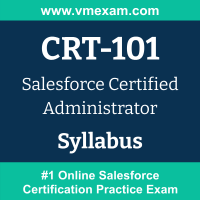 The Salesforce CRT-101 exam preparation guide is designed to provide candidates with necessary information about the Administrator exam. It includes exam summary, sample questions, practice test, objectives and ways to interpret the exam objectives to enable candidates to assess the types of questions-answers that may be asked during the Salesforce Certified Administrator exam.
The Salesforce CRT-101 exam preparation guide is designed to provide candidates with necessary information about the Administrator exam. It includes exam summary, sample questions, practice test, objectives and ways to interpret the exam objectives to enable candidates to assess the types of questions-answers that may be asked during the Salesforce Certified Administrator exam.
It is recommended for all the candidates to refer the CRT-101 objectives and sample questions provided in this preparation guide. The Salesforce Administrator certification is mainly targeted to the candidates who want to build their career in Administrator domain and demonstrate their expertise. We suggest you to use practice exam listed in this cert guide to get used to with exam environment and identify the knowledge areas where you need more work prior to taking the actual Salesforce Administrator exam.
Salesforce CRT-101 Exam Summary:
|
Exam Name
|
Salesforce Administrator |
| Exam Code | CRT-101 |
| Exam Price |
Registration fee: USD 200 Retake fee: USD 100 |
| Duration | 105 minutes |
| Number of Questions | 60 |
| Passing Score | 65% |
| Recommended Training / Books |
Preparing for Your Salesforce Administrator Certification (CRT101) Essentials for New Lightning Experience Administrators (ADX201) |
| Schedule Exam | Kryterion Webassessor |
| Sample Questions | Salesforce CRT-101 Sample Questions |
| Recommended Practice | Salesforce Certified Administrator Practice Test |
Salesforce Administrator Syllabus:
| Section | Objectives | Weights |
|---|---|---|
| Configuration and Setup |
- Describe the information found in the company settings (for example, company settings fiscal year, business hours, currency management, default settings). - Distinguish and understand the administration of declarative configuration of the User Interface (for example, UI settings, app menu, list views, global actions, Lightning App Builder). - Given a scenario, demonstrate the proper setup and maintenance of users. - Explain the various organization Security Controls (for example, Setup Audit Trail, Login Hours, Session Settings). - Given a user request scenario, apply the appropriate security controls based on the features and capabilities of the Salesforce sharing model (for example, public groups, org-wide default, sharing: roles, subordinates, hierarchy, report and dashboard folders). - Given a scenario, determine the appropriate use of a custom profile or permission set using the various profile settings and permissions. |
20% |
| Object Manager and Lightning App Builder |
- Describe the standard object architecture and relationship model (for example, standard object, parent/child, master detail/lookup/junction relationships, and record types). - Explain how to create, delete, and customize fields and page layouts on standard and custom objects, and know the implications of deleting fields. - Given a scenario, determine how to create and assign page layouts, record types, and business processes for custom and standard objects. |
20% |
| Sales and Marketing Applications |
- Given a scenario, identify the capabilities and implications of the sales process (for example, sales process, opportunity, path, and forecast impact). - Given a scenario, apply the appropriate sales productivity features using opportunity tools (for example, dashboards, lead scoring, Einstein opportunity scoring, and home page assistant). - Describe the capabilities of lead automation tools and campaign management (for example, leads, lead convert, lead assignment rules, campaign and campaign members). |
12% |
| Service and Support Applications |
- Describe the capabilities of case management (for example, case, case assignment rules, and queues). - Given a scenario, identify how to automate case management (for example, support process, case auto-response rules, and case escalation). |
11% |
| Productivity and Collaboration |
- Describe the capabilities of activity management. - Describe the features of Chatter. - Describe the capabilities of the Salesforce Mobile App. - Identify use cases for AppExchange applications. |
7% |
| Data and Analytics Management |
- Describe the considerations when importing, updating, transferring, mass deleting, exporting, and backing up data. - Describe the capabilities and implications of data validation tools. - Describe the options available when creating or customizing a report or report type. - Describe the impact of the sharing model on reports. - Describe the options available when creating and modifying dashboards (for example, dashboard components, data sources, chart types, Subscribing, running user). |
14% |
| Workflow/Process Automation |
- Given a scenario, identify the appropriate automation solution based on the capabilities of the tool. - Describe capabilities and use cases for Flow. - Describe capabilities and use cases for the approval process. |
16% |
